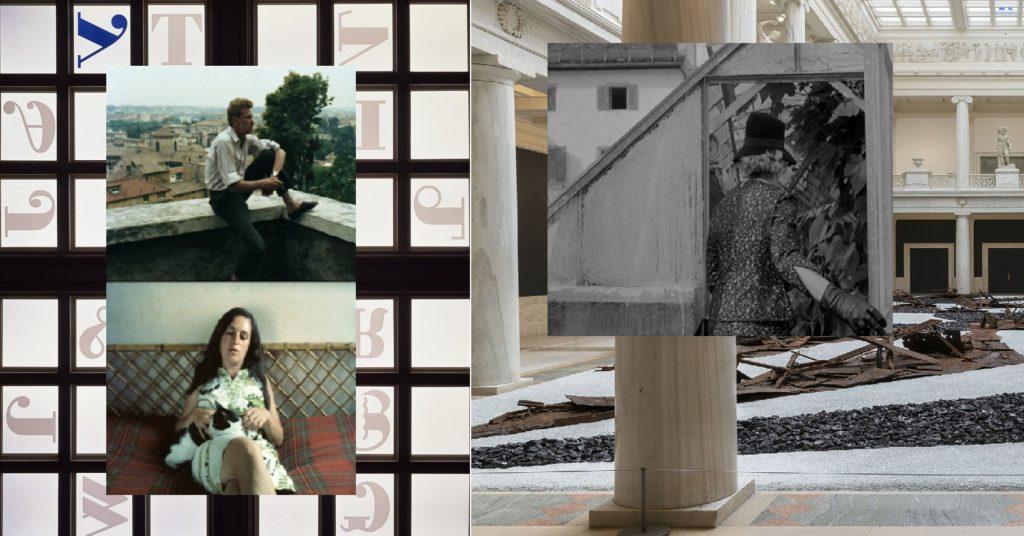From Nicht Versöhnt to Moses und Aron , one idea predominates, entirely contained in this title: not reconciled. Non-reconciliation : neither the union nor the divorce, neither the whole body (to preserve, to regret), nor the bias of desintegration, chaos (Nietzsche: one must desintegrate the universe, lose respect for all), but their double possibility. Straub and Huillet basically start from a simple irrefutable fact: Nazism happened. Because of Nazism, the German people of today is not reconciled with itself (Machorka-Muff, Nicht Versöhnt ), but the Jews aren’t either (Moses und Aron, Einleitung ). Nazism, like any power but more than any other, challenges and provokes the artists, and as a result artists no longer have the right to be irresponsible: Schoenberg is still not reconciled with Kandinsky, neither is Brecht with Schoenberg. In the Straubian system, a retro mode is simply ludicrous. Everything is in the present.
Non-reconciliation is also a way of making and producing films. It is the stubborn refusal of all the forces of homogenization . It has led Straub and Huillet to what might be called a “generalized practice of disjunction.” Disjunction, division, fission, taking seriously the famous “one divides into two.” The look and the voice, the voice and its material (the “grain”), the language and its accents are, as Chou En-lai said “different dreams in the same bed.” Films: the bed where what is disjoint, unreconciled, not reconcilable, “plays”, simulates, suspends unity. Not an (easy) art of décalage but the simultaneous head and tail of the one and the same piece, never played, always revived, inscribed on one side (the tables of the Law, Moses), stated on the other (miracles, Aaron).
What is it that imposes this homogenization against which one always has to disjoint, not reconcile, if not cultural imperialism which is in the process of submitting the industry film throughout Europe (England, Germany, Italy), to submit it to its manufacturing standards (a non-rational mess), to bring, for example, a man who, as first and against all, dared to film with direct sound and in dialect (Visconti: La Terra Trema ), to no longer think of his films – for the global art market – in any other way than directly dubbed into English, without anchor point, directly mutilated?
Anchoring films, images, voices means taking seriously the cinematic heterogeneity . And this anchorage, the idea that an image is only possible there and nowhere else, is not just a matter of language and voice. There is also the body. Strangely, the Straubian cinema allows us to understand that the naked body only has such exchange value, that it constitutes for capital (porn movies) such a precious signifier, because it has no attachment to History, because it makes us loose sight of it. Therefore it is necessary to anchor the body. I’m thinking of the shirts on the torsos of (true) farmers who lay their offerings before the golden calf in Moses and Aaron . And even of the erotism in the Straub films, discrete validation, of the most neutral parts of the body, the less spectacularly consumable (see images: an ankle, a knee).
– from Serge Daney ‘A Tomb for the Eye (Straubian pedagogy)’ reprinted in ‘Politics-Poetics Documenta X – the Book’ (1997). The placement of Bochner’s “I forget” over the hallway doors to the Hall of Sculpture adds another layer of meaning to an already loaded space. A scaled-down version of the Parthenon, this room introduces classical Greek culture into a New World museum, asserting a common heritage. For the 1988 International, Lothar Baumgarten added another layer by inscribing the Cherokee language, created by George Sequoyah in the 19th century, onto the glass ceiling, reasserting the presence of the Native American, which has, for the most part, been erased or forgotten. Again, an artist has added to or interpreted aspects of the Carnegie and its collections.
Inside the Hall of Sculpture is “From Smoke and Tangled Waters We Carried Fire Home” by Post Commodity, which references previous works and the history of Pittsburgh. Their stark arrangement of salvaged industrial materials—steel, coal and glass manufactured in Pittsburgh—echoes the work of Pedro Reyes from the last show, who contributed his music-making machines cobbled together from found objects. Like the music performed with those instruments, this inert composition comes alive with periodic rituals that resemble those enacted around Navajo sand paintings, the inspiration for the piece. Post Commodity, a collective of artists from indigenous nations, has found a connection between industrial Pittsburgh and the Navajos, but their vision of the city seems to be stuck in a past that has become so nostalgic, the dying dinosaurs of the steel industry. Like the sand paintings, the materials will be swept up at the end of the show and returned to the landscape, another disappearance of the past. But as one member of the group stated, when a door or portal closes, “some residue remains,” a thought appropriate to Lothar Baumgarten’s hope for the co-existence rather than the replacement of cultures.
– from Vicky A Clark ‘The 57th Carnegie International: Looking Forward While Mindful of the Past’, Pittsburgh Quarterly, January 2019. [For a nuanced discussion of the problems surrounding the permanent installation of Lothar Baumgarten’s The Tongue of the Cherokee , written in 2015 and so before Postcommodity’s work was (temporarily) installed in the Hall of Sculpture, see Kristina Mierins ‘A Foot Forward, or a Foot in the Mouth?’ ]
Like this: Like Loading...
Related
